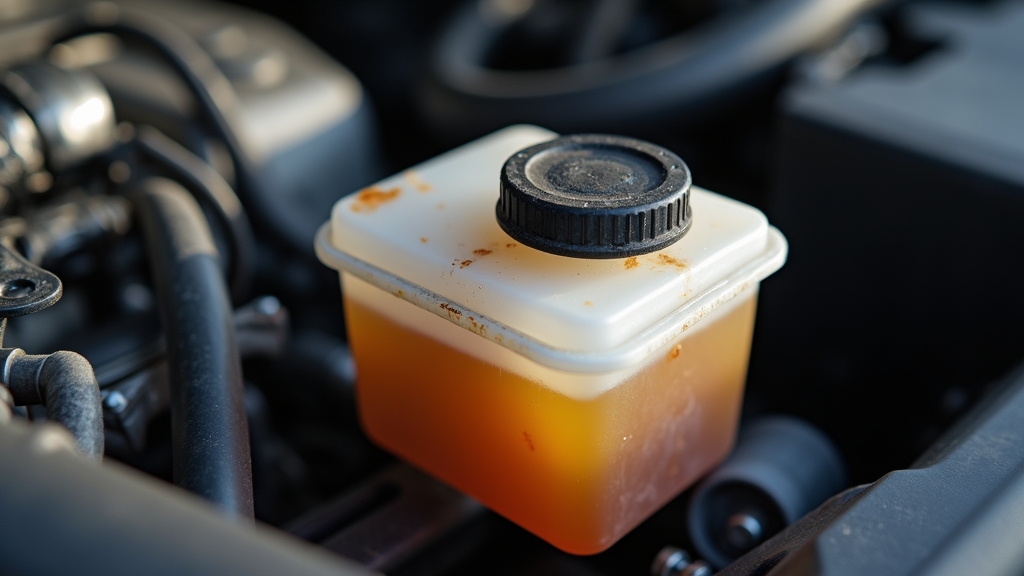Physical Address
304 North Cardinal St.
Dorchester Center, MA 02124
Physical Address
304 North Cardinal St.
Dorchester Center, MA 02124

You’ll typically need about 1 to 2 quarts of power steering fluid for most passenger cars, depending on the system size. Larger trucks and vans often require between 2 and 6 quarts.
Your reservoir usually has minimum and maximum level markers to guide you. Maintaining the proper fluid level prevents steering issues and pump damage.
If you want to manage your fluid correctly and understand how vehicle types and system designs affect capacity, there’s more to explore.

Although power steering fluid capacity varies by make and model, most passenger cars hold between 1 to 2 quarts (approximately 1 to 2 liters) of fluid in their systems. Typically, topping up requires about 1 liter, while a full flush replacement demands 2 to 3 liters to guarantee complete refill.
The total capacity depends on the specific steering system design and vehicle type, with hydraulic racks generally needing less fluid than larger vehicles. Using the wrong fluid type can cause damage to the power steering system, so always consult the owner’s manual for the recommended fluid.
Use ATF or hydraulic oil as specified by the manufacturer to ensure compatibility and prevent system wear. Temperature substantially affects fluid volume; cold fluid occupies less space than warm fluid, so reservoirs often feature minimum and maximum marks or dipsticks.
To maintain ideal fluid levels, you should monitor these indicators and account for expansion during engine operation to prevent overfilling, which can cause contamination or damage. Always refer to your vehicle’s specifications for precise capacity.
You’ll need to understand the specific fluid volume your power steering system requires to maintain ideal performance. The amount typically ranges from 1 to 2 quarts, but checking your vehicle’s manual is essential for accuracy.
Regular top-ups address minor losses, but a full fluid flush is necessary when contamination or degradation occurs. Always follow manufacturer guidelines to determine whether to flush or simply replenish fluid.
Maintaining the correct fluid level is crucial, as overfilling or underfilling can cause system damage or steering difficulties. Using fluids with the proper additive technology can help ensure optimal system performance and longevity.
When maintaining your power steering system, monitoring fluid volume is essential to guarantee ideal performance and prevent damage. Check fluid levels regularly, especially during oil changes or before long trips, using the reservoir’s “MIN” and “MAX” marks to avoid over- or underfilling.
Note that some vehicles specify fluid level with the engine hot or cold, so always follow the manual’s instructions. A full system flush may require up to 2 quarts, exceeding the typical 1-quart capacity of most passenger cars.
Larger trucks or vehicles with air or hydraulic brakes demand more fluid, often between 4.9 to 6.1 quarts. Since fluid volume varies by model and system type, consult your manufacturer’s guidelines to ensure precise fluid amounts and maintain system integrity.
Because power steering fluid generally has a higher viscosity than other automotive fluids, using the correct amount is crucial for optimal hydraulic performance. For vehicles built between 1998 and 2012, use MERCON V fluid as the recommended power steering fluid to ensure proper system functioning.
How do you decide between flushing and topping up your power steering fluid? Top-ups replenish lost fluid but don’t remove contaminants or air trapped in the system. They’re quick fixes for minor fluid drops and typically involve hydraulic fluids designed for vehicle systems.
Flushing, by contrast, replaces the entire fluid volume, eliminating dirty, degraded fluid and trapped air. It restores full hydraulic pressure and prevents pump and valve wear. Air in the system can cause noisy pumps and reduce steering responsiveness, making flushing essential to remove it completely.
Signs you need a flush include dark fluid, noisy pumps, stiff steering, or recurring low fluid levels. Professional flushes use machines to thoroughly clean lines and reservoirs, while partial flushes can be done manually but are less effective.
For long-term system health, flushing every 50,000–75,000 miles or sooner under harsh conditions is best. Always follow your vehicle’s manual for maintenance intervals and fluid specifications.

Although power steering fluid reservoirs vary in shape and placement across vehicle models, you can reliably identify them by their distinct filler cap marked with a steering wheel symbol. This symbol, often yellow on a black screw cap, confirms the reservoir’s purpose and is located near the top for easy access.
The reservoir is typically translucent plastic, allowing you to check fluid levels without removing the cap. Since there is no fixed volume for power steering fluid, the reservoir size and the amount it holds can differ significantly between vehicles. Proper maintenance tips for fluid levels help ensure the steering system functions smoothly and avoids damage.
| Feature | Description |
|---|---|
| Cap Marking | Steering wheel symbol, yellow on black |
| Reservoir Shape | Round or cylindrical, about 5 inches in diameter |
| Location in Engine Bay | Near the power steering pump on the driver’s side |
Since power steering fluid directly affects hydraulic pressure and system lubrication, maintaining the correct fluid level is critical to your vehicle’s steering performance and safety. Low fluid causes insufficient hydraulic pressure, making steering stiff and noisy while accelerating wear on the pump, seals, and hoses. Check for leaks regularly to avoid loose fittings.
It risks pump failure, leaks, and erratic steering responses, compromising control and safety. Conversely, overfilling increases reservoir pressure, potentially causing leaks or hose bursts. Excess fluid can aerate, reducing hydraulic efficiency and causing foaming, which leads to inconsistent steering feel.
Overfill may also mask minor leaks, delaying diagnosis. Both conditions elevate the risk of steering malfunction, so monitor fluid levels closely and address deviations promptly to guarantee ideal system function and safe vehicle handling. Regularly checking the fluid level using the reservoir markings or dipstick is essential to detect early signs of low fluid and prevent system deterioration.
You’ll find that passenger cars typically require about 1 to 1.5 liters of power steering fluid due to their smaller steering systems.
In contrast, trucks and vans often need up to 3 liters or more because of their larger, more complex hydraulic components. The dirt-holding capacity of components affects maintenance intervals and fluid quality requirements.
Understanding these variations helps guarantee accurate fluid replacement and system maintenance. Check the owner’s manual for specific fluid capacity and type recommendations for your vehicle.
When dealing with power steering fluid in passenger cars, you’ll find that fluid capacity varies considerably depending on the vehicle type and system design. Most passenger cars hold around 1 quart (1 liter) total, but exact amounts depend on your car’s make, model, and power steering system configuration.
Choosing the right fluid with proper viscosity and temperature range can enhance system performance and longevity. You’ll often see minimum and maximum fill indicators on reservoirs or dipsticks to guide you. Key factors affecting fluid capacity include:
For routine topping off, about 1 liter usually suffices, while full flushes require 2 to 3 liters. The total system capacity generally requires 2 quarts for thorough flushing.
Although power steering fluid capacity varies widely across vehicle types, trucks and vans typically require substantially more fluid than passenger cars due to larger system sizes and complexity. Proper maintenance often includes using compatible lubricants that meet industry standards to ensure system reliability.
You’ll find fluid capacities ranging from 2 to 6 quarts (1.9 to 5.7 liters), influenced by factors like pump reservoir size, steering gear type, and brake system integration.
For example, Ford trucks with air brakes hold about 5.2 quarts, while those with hydraulic brakes require 6.1 quarts. Proper capacity ensures optimal steering system performance and prevents issues caused by overfilling or underfilling fluid capacity.
Larger pickups, such as the Silverado 1500, need around 4 quarts during a full flush. Since brake systems affect fluid volume due to shared hydraulics and pressure differences, always consult your vehicle’s manual for precise amounts.
Proper fluid type, often synthetic ATF meeting MERCON® LV standards, is essential for system longevity and performance. Using fluids with appropriate corrosion inhibitors can also help protect steering components from wear and rust.
Because power steering fluid levels directly impact system performance and longevity, managing them with precision is essential. You should regularly check the fluid using the dipstick or reservoir markings, ensuring levels stay between minimum and maximum, accounting for temperature effects.
Power steering pumps operate at very high pressure levels, often up to 1,500 psi, which makes maintaining proper fluid levels critical for system safety and function. Use only the manufacturer-recommended fluid type. When topping off, add fluid incrementally and avoid overfilling to prevent leaks or damage.
For flushing, replace old fluid gradually until clear fluid circulates. Avoid using incompatible materials like Teflon tape in the system, as they can deteriorate and cause contamination.
Follow these best practices:
You can use automatic transmission fluid (ATF) as power steering fluid only if your vehicle’s manufacturer explicitly allows it. Some older models accept ATF types like Dexron III or Mercon, but many modern systems require specialized power steering fluids for proper seal compatibility and performance.
Using ATF without approval risks seal damage, leaks, and reduced pump life. Always consult your owner’s manual before substituting fluids to avoid costly damage.
Think of your power steering fluid as the lifeblood of your steering system. It needs rejuvenating every 30,000 to 50,000 miles or every 2 to 4 years to keep things running smoothly.
Check the fluid’s clarity and color regularly. If it looks dark or gritty, replace it sooner. Severe driving conditions or older vehicles demand more frequent changes to prevent wear, noise, and costly steering pump damage.
You’ll notice contaminated power steering fluid by changes in color—dark brown, grey, or black instead of clear pink or amber. Watch for sludge, debris, or metal shavings in the fluid. You might hear whining or grinding noises when steering or feel stiffness and slow response in the wheel.
Leaks under the car, burning smells, and overheating pumps also signal contamination. Regularly inspect fluid to prevent damage and maintain your steering system’s performance.
No, it isn’t safe to drive without power steering fluid. Your steering will become very stiff, especially at low speeds, increasing effort and reducing control. Running dry risks damaging the power steering pump due to lack of lubrication, leading to costly repairs.
If you suspect fluid loss, stop immediately, check and refill the appropriate fluid. Continuing to drive without it compromises safety and can cause permanent system damage.
Adding too much power steering fluid won’t directly damage your pump, but it can cause problems. Excess fluid expands when hot, overflowing and contaminating belts or engine parts, which may lead to belt slipping or damage.
This can indirectly affect pump function. To avoid issues, always fill to the cold or recommended level, not beyond the max mark. Proper fluid levels ensure ideal pump lubrication and prevent air entry which reduces efficiency.
Think of your car’s power steering fluid like the oil in a finely tuned watch—just the right amount keeps everything moving smoothly. Too little, and the system grinds; too much, and it overflows, causing damage.
By regularly checking the reservoir and knowing your vehicle’s specific fluid capacity, you guarantee precise steering performance and avoid costly repairs. Managing your power steering fluid is key to maintaining control and longevity in your vehicle’s operation.